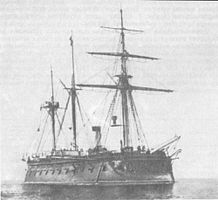Pervenez
|
The Первенец in 1873
|
||||||||||||||||
|
||||||||||||||||
|
||||||||||||||||
|
||||||||||||||||
|
||||||||||||||||
|
||||||||||||||||
Pervenez (Russian: Первенец) was the name of an armored floating battery (Russian: броненосная плавучая батарея) of the Imperial Russian Navy . The ship, built in 1861, was also listed in the Russian fleet lists as a coastal armored ship (Russian: броненосец береговой обороны). Disarmed in 1891, the ship remained in service until the late 1950s, making it one of the ships with the longest service life.
history
The Pervenez , ordered in 1861, was the second armored and the first larger armored warship of the Imperial Russian Navy after the gunboat Opyt built in 1861 . In the German translation the name means "The Firstborn". In practice it is a small casemate ship . The ship was launched on May 6, 1863 at Thames Ironworks and Shipbuilding and Engineering in London . Due to the deterioration in relations between the United Kingdom and Russia, the frigates General-Admiral and Oleg were commissioned in July 1863 to transfer the ship to Kronstadt, despite the fact that it was not yet completed . The armament of the Pervenez was not yet scaffolded. On August 5, 1863, the ship reached Kronstadt. The commander of the Admiral General , Vasily Alexandrovich Stetsenko, received the Order of St. Vladimir 3rd Class for his services during the crossing . After the armament of 26 60-pounder cannons, the ship was put into service at the end of the year.
The displacement of the Pervenez was 3622 t. The machine system, which consisted of a steam engine and two boilers, developed 1,067 hp. Propelled by a screw, the ship reached a speed of 8 knots. The ship was armored along the entire length of the battery deck. The armor amidships was 114 mm thick and 102 mm at the ends. The armor was backed with teak with a thickness of 254 mm. This should prevent parts of the brittle armor from flaking off when hit.
Following the example of the Pervenez , two more floating batteries were built in St. Petersburg. The Ne tron menja (translated: "Don't touch me") was put into service on July 6, 1865, the Kremlin in the first half of 1867. The Ne tron menja received 24 60 pounders of the same type as the Pervenez , but were already in 1866 the cannons were exchanged for 17 8-inch guns with rifled barrel, only a 60-pounder remained on board. The Perwenez got two 8-inch rifled guns in 1872. The Kremlin was armed with six 8-inch guns and 10 60-pounders from the start.
The armament of the floating batteries was later changed again. The Russian ironclad Pervenets was 1,891 six guns of the caliber 203 mm, six 152 mm cannon model 1877 , two 120 mm, 87 mm and 47 mm cannons and five 37-mm-revolver cannon of Hotchkiss. On February 1, 1892, all three floating batteries of the Baltic Fleet were reclassified as coastal armored ships.
On September 2, 1905, the armament of the Pervenez was dismantled. However, the hull of the ship was still usable, so that the ship was used as a propulsion-less barge until the late 1950s .
Designations
During its long service life, the ship had different names and board numbers:
- Pervenez (Первенец) from 1861 to 1908
- No. 1 (Баржа №1) from 1908 to 1931
- KP-3 (КП-3) from January 1, 1932 to July 12, 1942
- K-4199 from July 12, 1942 to May 16, 1949
- BSN-491000 (БСН-491000) from May 16, 1949
Web links
- Photo collection (Russian)
literature
- А. Б. Широкорад : Россия - Англия: неизвестная война, 1857–1907. Издательство ACT, 2003, ISBN 5-17-017796-8 .
